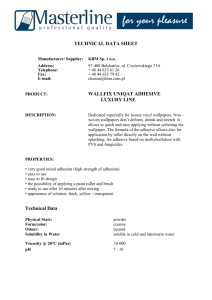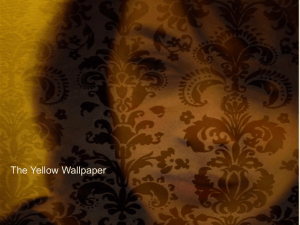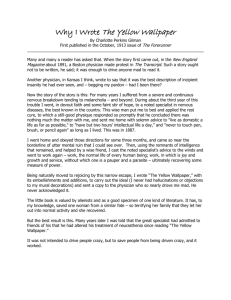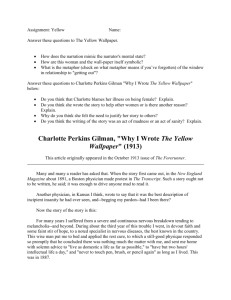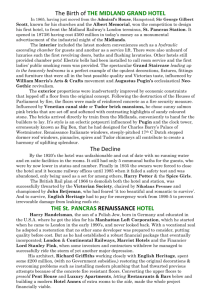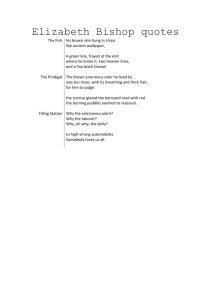conservation of wallpapers from st pancras chambers
advertisement
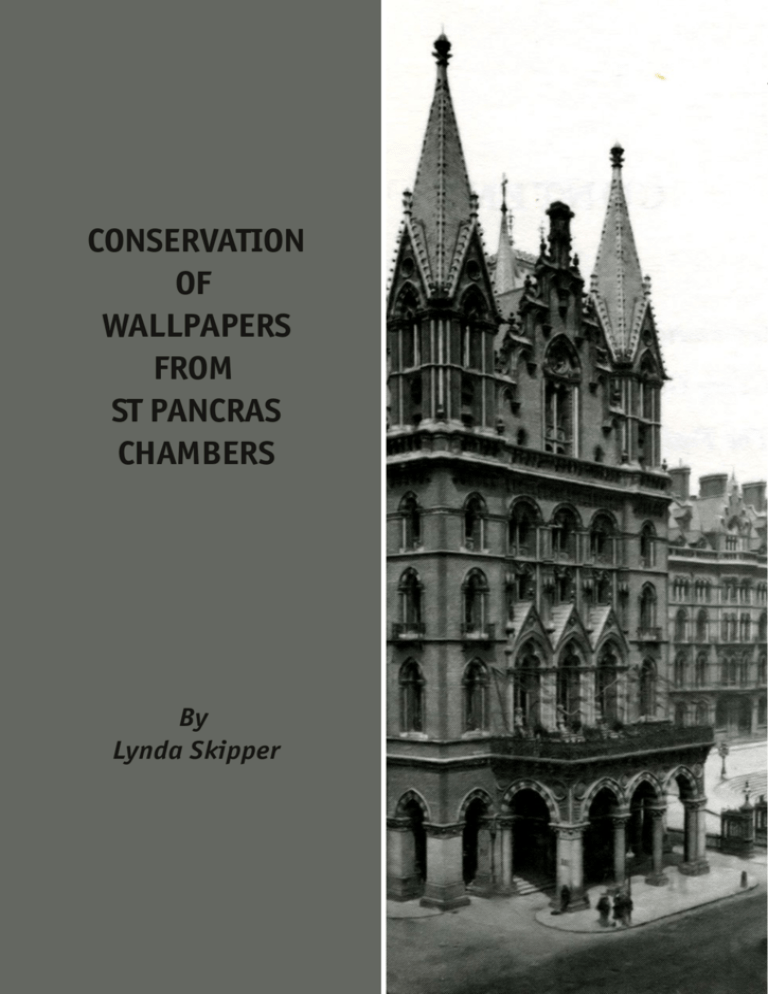
CONSERVATION OF WALLPAPERS FROM ST PANCRAS CHAMBERS By Lynda Skipper CONSERVATION OF WALLPAPERS FROM ST PANCRAS CHAMBERS The renovation of St Pancras Chambers (Midland Grand Hotel) in London provided an excellent opportunity for in‐depth research into the wallpapers used in decorating this historic building. Initially a hotel owned by Midland Railway, the building was subsequently used as offices and staff accommodation by British Rail before it finally closed in the 1980s. During the restoration project, many wallpapers were uncovered from previously hidden areas, in addition to other papers that were still on view on the walls. All the wallpapers were at high risk from damage and loss during the extensive building works, and in order to keep a record of that evidence wallpapers were collected and removed from the site. Spanning just over 100 years of wallpaper from the 1870s to the 1980s, the papers were cleaned and conserved, and stored within Melinex pockets, acid free envelopes or rolled Melinex, as appropriate. They now comprise a historic wallpaper archive, available for access for researchers, students and other interested parties, held at the University of Lincoln. Introduction St Pancras Chambers, originally known as the Midland Grand Hotel (Figure 1) was designed by Sir George Gilbert Scott and opened in the 1870s in the St Pancras area of London. The building was commissioned by the Midland Railway Company, who also commissioned the neighbouring St Pancras Station, enabling Midland Railway to run their own rail route into London [1]. The hotel was in use until 1935, and was then converted to offices and staff accommodation, but then stood empty for over 20 years until a recent redevelop‐ ment project into a hotel and apartments by the Manhattan Loft Corporation [2]. The building re‐ opened as a hotel in 2011. As part of this redeve‐ lopment, Crick Smith Conservation, a commercial arm of the University of Lincoln’s Conservation Department, carried out in depth investigations to determine the historic paint schemes used in the building. When evidence of wallpapers was also found, this project was set up in conjunction with English Heritage to investigate, rescue and conserve wallpapers from the building. St Pancras provided a unique opportunity to dis‐ cover the decorative tastes of a commercial build‐ ing in the gothic revival style, and the decorative e‐conser vation choices of later occupiers, about which very little information has been previously recorded. This was a particularly unusual project as samples could be collected from the entire building, and the renovations revealed wallpapers that had been covered during earlier alterations, that would not otherwise be accessible. The decora‐ tion and furnishings of the hotel on the upper floors were much more modest than those on the lower floors [1], reflecting the hierarchy of uses of the building with servants rooms in the attic and the grandest rooms on the ground floor. Hence this project also provided a view of how different types of paper were used throughout the building, and how wallpapers were chosen to reflect this cost gradient. This project was an emergency rescue attempt to remove examples of wallpapers that would other‐ wise have been lost during building works, and was also an opportunity to remove samples that would otherwise be covered during the redecor‐ ation. Suitable conservation treatments were used to clean and preserve the wallpapers, and storage methods were researched, in order to then establish a new archive at the University of Lincoln, allowing access to the collection for study and research purposes. 129 LYNDA SKIPPER Figure 1. The Midland Grand Hotel at St Pancras Station, Euston Road, London, post 1874. © National Archive for Historic Decoration, University of Lincoln. Figure 2. The author retrieving a fleur‐de‐lis style wallpaper from the 2nd floor of the building. Retrieving the wallpapers from St Pancras majority of wallpapers coming from the bedrooms and corridors on the 2nd – 5th floors. Only three rooms on the top floor, which had been used as accommodation for staff in the hotel, contained any examples of wallpaper. As some pieces were fragments of the same design from one room, or samples of the same design found in multiple rooms, assessment after the visits showed 99 different designs were retrieved. Four days were spent at St Pancras by the author, retrieving papers that had been found during building works (Figure 2). While the visits took place over 12 months (with a delay due to a fire which prevented access) it was necessary to act quickly as new wallpapers were uncovered, be‐ cause these were areas that were actively being renovated by the building teams. Due to the short time frame and the large number of wall‐ papers (spread around more than 500 rooms) the wallpapers had to be removed from the walls as rapidly as possible. To illustrate the urgency of the task and need for a rapid removal, in one incident the author was surrounded by builders waiting to knock down a wall, but as the wallpaper was still attached, they were asked to wait until after the removal had taken place! 500 pieces were retrieved from corridors, stair‐ wells and rooms throughout the hotel, with the 130 The first stage when any wallpapers were found was recording. Comprehensive photographs were taken to record the position of the paper in the room, and the size and design. On occasion it was not possible to remove the papers, either due to lack of scaffold access at short notice where the only remaining paper was high up on the walls, or where the wallpaper had been too badly damaged to remove, so the photographs are the only record of those pieces. However, it was possible to remove examples from the majority of wallpapers. Indeed, in some cases, such as the 3rd floor corridor e‐conser vation CONSERVATION OF WALLPAPERS FROM ST PANCRAS CHAMBERS Figure 3 (above). Paper in the 3rd floor corridor, exposed by removal of ducting, is very poorly attached to the wall. Figure 4 (left). Wallpaper from room 2.023 showing vertical staining pattern. Instead, after checking that the colours in the papers were not water soluble, direct water spray was used and allowed to soak into the paper, before removal with a scalpel. (Figure 3), the paper was already almost entirely detached from the wall and was easily removed dry, using only a scalpel where necessary. A few wallpapers did not respond to the dry re‐ moval method and so were treated with water to aid removal. Steam was not practical for removal of the wallpapers in this project because of the lack of time and no suitable electrical connection. e‐conser vation In cases where water based removal was not possible, it was decided to remove the plaster and wallpaper together using a chisel, and separate them later. The hotel was replastered during renovation work so it was not critical to leave the plaster in situ. The weight of the plaster made it technically difficult to remove larger pieces, es‐ pecially when combined with the inherent insta‐ bility of a large plaster section when detached from a supporting wall. However, it was possible to remove small sections using this method. The sizes of the wallpapers found ranged from tiny fragments to entire rooms. While the aim was to sample a pattern repeat for each of the designs, for the earliest papers there was not always enough 131 LYNDA SKIPPER Weight Melinex Wallpaper Gore‐tex Wet blotting paper Melinex Figure 5. Schematic showing use of Gore‐tex to separate layers via single sided humidification. surviving wallpaper for this to be achievable, so in those cases as much as possible was kept. Condition of the wallpapers The main environmental factors causing deterio‐ ration to wallpapers within the hotel were light, humidity and dirt. The building had been neglected while it stood empty and there was evidence of many leaks. As well as water staining of the wall‐ paper, high humidity had caused problems. As a consequence of this mould growth was observed in many areas. Damage also occurred to the wall‐ papers from previous alterations within the build‐ ing, such as iron staining and holes from pipework. Dirt and discolouration was a common problem with the wallpapers. The building generally was very dirty and dusty, partly due to ongoing reno‐ vation work and partly due to years of neglect and lack of cleaning. An example of this is the wall‐ paper shown in Figure 4, where dirt has run down the wallpaper, carried by water. As the water dried, it left the dirt behind. 132 Conservation treatments Papers were all condition surveyed following re‐ moval, which allowed a system of prioritising to be set up. Papers that were unstable due to plaster or paint layers, or those where the design was obscured by paint or other layers of wallpaper, were prioritised for conservation treatments carried out at the University of Lincoln. All pieces have been conserved and placed into archival storage materials using methods described below. Removal of plaster Plaster was removed using a preservation pencil with ultrasonic humidifier, plus mechanical scraping with a scalpel [3]. Tests over a range of temperatures showed that a high temperature setting was the most effective method and so 95º C was used. The humidity and mist levels were varied between 30% and 100% according to the paper treated. Although the most efficient method was to use high humidity, some of the pieces needing plaster removal had water sensi‐ tive pigments. Therefore low mist and humidity e‐conser vation CONSERVATION OF WALLPAPERS FROM ST PANCRAS CHAMBERS Figure 6. Using a smoke sponge for dry cleaning of wallpaper. The area bottom left of the photograph has been cleaned with a smoke sponge. The remaining areas are uncleaned. levels were used on the water sensitive pieces to prevent damage. Separating layers of paper and paint A progressive approach to separation of wallpaper layers was taken. A few layers could be removed dry, due to their separation when removed from the damp environment of St Pancras to a drier area. However, the most effective method of re‐ moving paint and paper layers with water resistant wallpapers was the application of water, in the form of steam provided by a preservation pencil and ultrasonic humidifier, which softened the adhesive holding the layers together [3]. Gore‐tex was successfully used to introduce con‐ trolled levels of moisture to separate layered water sensitive papers, as shown in Figure 5 [4]. The wallpapers gradually became humidified and separated without damaging the papers or causing excessive bleeding of colours. The wallpapers were e‐conser vation left in the Gore‐tex for between 30 minutes and overnight, depending on the thickness of the layers and the amount of humidity needed to soften the adhesive. Cleaning methods After separation, cleaning was necessary. Loose dirt was removed with a brush unless friable pig‐ ments were present. A cleaning sponge (smoke sponge) was then used, which quickly removed the majority of the surface dirt on the papers (Figure 6). Where further cleaning was needed, full immersion in water proved suitable in some cases particularly for the later, machine printed papers. If wet cleaning was necessary but immersion in water was not possible due to water soluble pigments, Gore‐tex was used. A Gore‐tex sandwich was therefore prepared using the method suggested by Dobrusskin [4]. Gore‐tex provided a barrier 133 LYNDA SKIPPER moved the surface of the wallpaper as well. Ace‐ tone was an effective solvent to soften the varnish. In order to control the exposure to acetone, blotting paper was soaked in acetone and Gore‐ tex was laid between the blotter and the wallpa‐ per. This was left for 15 minutes to soften the varnish and then the varnish and paint were re‐ moved mechanically. This was repeated 5 times in order to remove the whole surface layering. In order to remove any remaining solvent, the paper was washed by lightly spraying the verso with water and then quickly blotted dry. This prevented excessive moisture reaching the design area, and so the slightly water sensitive pigments were not affected. Figure 7. Wallpaper during conservation treatment. An example of a wallpaper from the ground floor with numerous tears and holes, which has been partially backed with Japanese tissue to support damaged areas. through which moisture vapour could pass, but water itself was excluded. The sandwich method with blotting paper meant that dirt was drawn into the blotter and out of the wallpaper, along with the moisture. After two days of cleaning, a small amount of transference of the design both onto the back of the wallpaper and onto the Gore‐tex occurred, but no significant bleeding of colour was observed. If this treatment had been continued longer it may have been even more successful, but it was felt that the risk of mould growth outweighed the benefits of further cleaning. Gore‐tex was also used in the application of solvents where necessary. For example, paper from room 4.024 (4th floor) had a thick layer of paint applied to the surface. It was not possible to remove the paint without taking the top layer of varnish off the design. The design was slightly water sensitive, and dry removal of the paint re‐ 134 Other conservation treatments carried out included consolidation of flaking pigments with carboxy‐ methyl cellulose at 0.5% concentration, and paper repairs using Gampi and Minogami Japanese pa‐ pers (Figure 7). Storage of the wallpapers The wallpapers vary in size from a few millimetres to over a metre in length. The most appropriate storage for papers is to leave them flat, as this prevents damage, and rolling papers may increase stress on the pigments and on the paper support. However, flat storage is not a practical option for the largest pieces due to space constraints. After visits to view methods of storage used in the Whitworth Art Gallery in Manchester and the Victoria and Albert Museum in London, it was decided that this wallpaper collection should be stored mainly in Melinex, but with acid free paper envelopes made for the papers with potential for pigment loss. The Melinex encapsulation was done using a heat sealer, which melts the edges of the Melinex sheet together. In order to avoid total sealing of the environment around the e‐conser vation CONSERVATION OF WALLPAPERS FROM ST PANCRAS CHAMBERS Melinex sheet Linen tape Melinex strip, heat sealed in placer Holes in Melinex strip for tape to come through Figure 8 (above). Schematic of Melinex storage design for rolled wallpapers. Figure 9 (right). An example of the wallpaper stored around a Melinex roll. wallpaper one corner of the pocket was re‐ moved. This should allow some air circulation and prevent establishment of a microclimate. Larger papers needed rolled storage. After a visit by the author to examine the Mylar rolls at the Whitworth Art Gallery in Manchester, this ap‐ peared to be a suitable storage solution for the St Pancras papers. The Whitworth needed a large number of these outer wrappers, so had them custom made, with the tapes able to be pulled through punched holes to adjust for the size of roll [5]. As a much smaller number were needed for this project, it was decided to make these in house, using two grades of Melinex sheet with linen ties. Thick Melinex was used for the main body of the roll, with thinner Melinex used to hold the linen ties in position. A plan of these rolls is shown in Figure 8. Although this provided a suitable outer surface, the wallpapers needed an inner support around which they could be rolled. Therefore, the author decided to make a Melinex roll, as this material was inert, stable, strong and readily available. These central rolls were heat sealed to keep e‐conser vation them circular, but this meant a fairly large dia‐ meter was needed in order to fit them onto the heat sealer. The advantage of heat sealing the inner roll was that no added chemicals or adhe‐ sives are involved, so there was no chance of any reaction with the wallpapers during storage. Figure 9 shows a completed storage roll in use. Investigating the origins of the wallpaper The earliest primary evidence of wallpaper being used in St Pancras is from a photograph depict‐ ing a 1st floor sitting room in 1876 (Figure 10). Previous investigations by Crick Smith Conser‐ vation found no trace of this original paper, except for traces of paste and lines on the wall where the dado used to be. This was probably stripped when electricity was installed around 1886 with just traces of paste remaining. Given 135 LYNDA SKIPPER Figure 10. Sitting room, Midland Grand Hotel, St Pancras Station, c 1876. © National Archive for Historic Decoration, University of Lincoln. the lack of very early papers found, it seems likely that this removal was employed throughout the building, with remaining papers generally quite fragmentary. An example of this is the wallpaper found in two of the 3rd floor bedrooms. This is a William Morris design, Venetian pattern, produced by Jeffrey and Co. [6] This dates the paper to c. 1871, and would have been part of the original scheme, used in the hotel in both blue and green. Although it is difficult to confirm manufacturers and designers without locating an exact dupli‐ cate of that pattern with a known maker, Jeffrey and Co. seems to be a likely candidate for the manufacturer of many of the early papers. For a big project such as a hotel, the simplest option for interior decoration would be to have all the wallpapers supplied by one company. Jeffrey and Co. was renowned for its quality and produced wallpapers by many leading designers such as William Morris, Owen Jones and Charles Voysey 136 [7]. Two of the slightly later papers (1900‐1910) share strong similarities with wallpapers produced by Charles Knowles and Co. A later 1920s paper was most probably produced by Arthur Sanderson. Conclusions Through this project important new information has been found regarding the decoration of the hotel and the later offices and accommodation. All the samples have been fully documented, cata‐ logued and recorded. It seems that the general decorative schemes of the hotel were of large floral patterns in the lower floors with cheaper, smaller floral pattern paper on the upper floors. It is likely that the wallpapers for the original scheme were provided by Jeffrey and Co, with later additions by companies such as Charles Knowles and Sanderson. Clearly the use of prestigious designers was important, as shown by the choice of papers by designers such as William Morris, e‐conser vation CONSERVATION OF WALLPAPERS FROM ST PANCRAS CHAMBERS Owen Jones and Bruce Talbert. This highlights the significance of the wallpapers in the decoration of the hotel. In the areas with high usage more hard wearing wallpapers were often in use, either varnished or Lincrusta/Anaglypta based, though again mainly with a floral element to the design. The use of Gore‐tex to protect water‐sensitive pigments on the wallpapers was a very useful re‐ source for allowing cleaning and conservation of the papers to progress. The St Pancras project has led to the creation of an archive of historic wallpapers that will be preserved at the University of Lincoln, giving access to this collection for re‐ searchers, owners, students and other interested parties. All the 99 different wallpapers collected were historically valuable in terms of how the in‐ teriors of St Pancras developed over time, so it was important to treat them according to their conser‐ vation needs, irrespective of the sample age. artistic works on paper : proceedings of a conference, Symposium 88 ‐ Conservation of Historic and Artistic Works on Paper, Ottawa, 3‐7 October 1988, Canadian Conservation Institute, Ottowa, Canada, 1994 [4] S. Dobrusskin, H. Singer, and G. Banik, “Hu‐ midification with moisture permeable materials”, Restauro 97(2), 1991, pp. 102‐111 [5] N. Walker and C. Woods, “Off the wall: towards new storage solutions”, The Wallpaper History Review, 2004, pp. 47‐50 [6] C. Oman and J. Hamilton, Wallpapers ‐ a history and illustrated catalogue of the collection of the Victoria and Albert Museum, Sotheby, London, 1982 [7] L. Jackson, 20th century pattern design: textile & wallpaper pioneers, Mitchell Beazley, London, 2002 Acknowledgments Thanks to Dr Rachel Faulding of Crick Smith Con‐ servation and the University of Lincoln for her advice during the project. Thanks also to Lesley Hoskins for identification advice, and to staff at the Whit‐ worth Art Gallery, Manchester and Victoria & Albert Museum, London for their help and hospitality. References [1] J. Simmons and R. Thorne, St Pancras Station, Historical Publications, London, 2003 [2] Manhattan Loft Corporation, “St Pancras Renaissance Hotel”, [URL] (accessed 4/7/12) [3] H. Norville and P. Larminie, “Turner at the Tate”, in H. D. Burgess (ed.), Conservation of historic and e‐conser vation LYNDA SKIPPER Conservator‐restorer Contact: lskipper@lincoln.ac.uk Dr Lynda Skipper is employed as a lecturer in Conservation at the University of Lincoln, and is programme leader for the MA in Conservation of Historic Objects. After initially studying science to PhD level at the University of Cambridge, she then studied the Graduate Diploma and Masters in Conservation at Lincoln. She was initially self employed as a project conservator by a privately owned historic house. Subsequently, she worked for the Science Museum and the National Trust, before returning to Lincoln in 2011. Her research interests include metals, particularly related to classic vehicles, plastics, and the application of science to conservation. 137 No. 25, Spring 2013 ISSN: 1646‐9283 Registration Number 125248 Entidade Reguladora para a Comunicação Social LICENCE Attribution‐Noncommercial‐No Derivative Works 2.5 Portugal You are free: to Share — to copy, distribute and transmit this work Property e‐conservationline, Rui Bordalo Periodicity Under the following conditions: Biannual Cover The Homer Telephone Exchange Pratt Museum in Homer, Alaska, USA Photo by Seth Irwin Attribution. You must attribute the work in the manner specified by our licence, best by linking to CC website. Editorial Board Rui Bordalo, Anca Nicolaescu Collaborators Noncommercial. You may not use this work for commercial purposes. Ana Bidarra Daniel Cull Rose Cull Graphic Design and Photography Anca Poiata No Derivative Works. You may not alter, transform, or build upon this work. Execution Rui Bordalo Address Rua Germano Vigdigal, 17, r/c D 7005‐160 Évora, Portugal www.e‐conservationline.com All correspondence to: general@e‐conservationline.com e‐conservationline informs that the published information is believed to be true and accurate but can not accept any legal responsibility for any errors or omissions that may occur or make any warranty for the published material, which is solely the responsability of their authors.
